|
Usual Suspects
If Orion publicity supremo Angela McMahon ever fancied a quieter job – herding cats, for example – she would do well to cite her experience in marshalling the “movers and shakers of the crime world” (her words) at a recent lunch in a stylish Covent Garden restaurant for two of Orion’s star authors.
 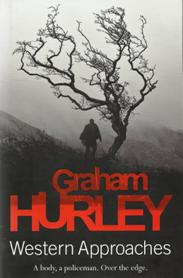
The authors in question, both with new books with new characters and new settings, were Robert Wilson and Graham Hurley. Well-known for his novels set in West Africa, Spain and Portugal, Robert Wilson has now opted for London as the setting for Capital Punishment which introduces his new hero, ex-policeman turned private security specialist, Charles Boxer. After twelve books over twelve years featuring his Portsmouth cop duo Faraday and Winter, Graham Hurley moves his setting ever westward, to Exmouth, to begin a new series starring DI Jimmy Suttle in Western Approaches.
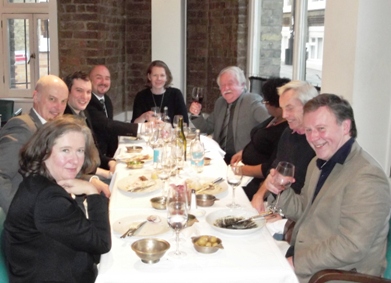
I felt some sympathy (between multiple courses of fine cuisine and the excellent wines on offer) for the well-behaved but outnumbered authors, surrounded as they were by the usual boisterous suspects of crime fiction reviewers which included my old chumette Natasha Cooper, Professor Barry Forshaw, my dashing young Padawan Jake Kerridge, the debonair Chris Simms and my Shots colleague, the voluptuous Ayo Onatade.
Sadly, I was able to exchange only a few words with Robert Wilson, who was kept deeply engaged by Natasha Cooper and poor Graham Hurley was monopolised by Professor Forshaw when he discovered they both shared a fanatical devotion to the sport of offshore rowing, which sounded rather strenuous, possibly wet and probably dangerous to me.
Carry On Sophie
There’s a new Sophie Hannah novel, The Carrier, out from Hodder this month, which is good news all round and I am sure will garner rave reviews.

Now while Sophie has been rightly praised for her sinuous plotting, dark psychological insights, precision-layered structure and the rhythm of her prose (she’s also a poet, don’t forget), I have always felt that she does not get enough credit for being funny. In past novels, she has written some wincingly funny (that is to say dead accurate) bitchy female dialogue and in The Carrier, the opening scenes in a German airport are stuffed full of cheeky observations and witty asides which a lesser writer such as myself would have milked to death or turned into farce.
Library News
A polite and timely reminder that my Reader’s Ticket for the magnificent British Library has expired could not have been more convenient for I can now kill two birds with one stone on my visit next week. Not only can I renew my reader card but I can take in the current exhibition Murder In The Library: An A-Z of Crime Fiction which has been mounted, in believe, in conjunction with The Folio Society and which runs until May.
,%20an%20intriguing%20book%20with%20an%20real%20jigsaw%20puzzle%20providing%20the%20solution%20(low).jpg)
The logo adopted by the exhibition features an image from The Jigsaw Puzzle Murders from 1933 (by Walter Eberhardt if you had to ask, as I did).
I will be making a rare public appearance at another distinguished London library, Victoria Library on Buckingham Palace Road on Monday 18th February (at 6 p.m.) as a guest of Westminster Libraries, in the company of two splendid thriller writers: Robert Ryan and Andrew Williams.
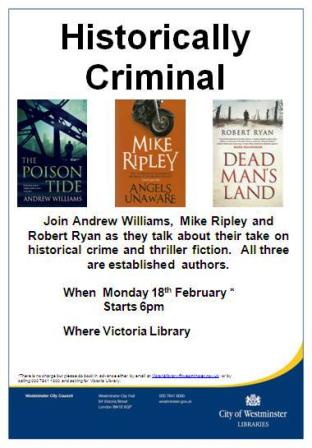
When initially approached by Westminster Libraries late last year to give a talk, I was more or less given carte blanche in terms of subject matter as long as it involved crime fiction. After considerable rumination, I decided that as some of the most interesting crime fiction being written today has a historical setting (sometimes referred to as ‘history-mysteries’), I would take this Historically Criminal thesis as the main text of my sermon and invite along two authors whose recent books, both with World War I settings, I much admired in order that they might agree with me.
As Victoria Library is but a brief stroll from Buckingham Palace, who knows what sort of an audience we might attract? The event is free, as it should be in a public library, but booking a place is advised and can be done by emailing victorialibrary@westminster.gov.uk or by calling 020 7641 1300 and asking to be put through to Victoria Library.
Coda to Christmas
Following the feasting and festivities over Christmas, Twelfth Night is always a rather restrained affair as the woodsmen from the estate come in to dispose of the giant Ripster Hall Christmas tree (claiming the firewood in lieu of payment) and the decorations and cards are taken down. One of those cards contained the excellent news that my old and distinguished friend Catherine Aird will have a new book out in May entitled Dead Heading, but one was particularly poignant in that it came, this year, from Pat Hill instead of Reginald and Pat Hill and as if to prove that the New Year is a sad and dangerous time for crime writers, I hear that Gwendoline Butler has passed away, aged 90, after a long illness.
Now I cannot say that I knew Gwendoline well and indeed had not seen her for over fifteen years, but in the early 1990s we shared the same publisher and appeared together in public several times.
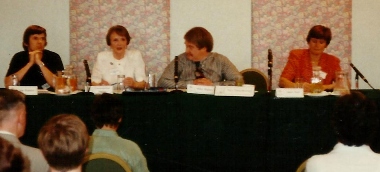
Most famously, she appeared (second left above) on a panel I chaired at a Shots-on-the-Page convention in Nottingham, along with Janet Neel and Ian Rankin, discussing the pitfalls (or advantages) of being writers who had or had not ‘given up the day job’. Janet Neel and I represented crime writers who still retained proper jobs, whilst Gwendoline and Ian advocated the pure writer’s life.
When my first novel came out, I was sent on a four-author publicity tour by our publisher, along with Gwendoline, Magdalene Nabb and Peter Turnbull. The first event, in Southend, went well enough but the second was scheduled for a Saturday afternoon in a bookshop in Coventry in direct competition with an important local football match.Magdalene Nabb and Peter Turnbull could not make it, so Gwendoline and I manned the barricades and sat behind a large pile of our books for three hours in an almost deserted bookshop. We had a very pleasant chat and put the crime writing world to rights, but no one – and I mean no one – came to talk to us or, heaven forfend, buy a book. Until, that was, at 5 p.m., as the shop was preparing to close, an attractive young lady approached our groaning table and asked me to sign one of my books for her. I did so; feeling rather embarrassed as Gwendoline was far better known than I and suggested that the young lady try one of hers as well. “Oh I’ve read them all,” she replied with a charming smile. “I’m her daughter, come to give her a lift home.”
Some while later when we both had new books out at the same time from the same publisher, three ‘rogue’ copies slipped through the net and out of the print works which had a chapter interposed. In other words, a chapter from one of Gwendoline’s ‘John Coffin’ mysteries appeared without warning in the middle of my Angel Hunt. Fortunately the mistake was spotted early on and only two copies escaped into trade, both turning up for sale at Murder One on London’s Charing Cross Road. I still have one and treat it as a prize possession. I’m not sure if Gwendoline ever got a copy of her novel with a random chapter from Angel Hunt sandwiched into it, or what she thought of the incident. She was far too polite to mention such things.
Policemen Not Getting Younger
It has been reported on the BBC (and therefore might be true) that British policemen are no longer getting younger, but older as the Force (may it always be with us) fails to attract new, young recruits. The same cannot be said of crime writers.
When, in 1988, I first joined – with an eagerness which betrayed my innocence – the Crime Writers’ Association, I was one of just three members below the age of 40 and only Philip Kerr and Ian Rankin were younger than me. By today’s standards, we all would probably have been classed as grumpy old gits.
Swedish author Kristina Olhsson’s first novel Unwanted made her a ‘No.1 Bestseller’ in Sweden (as all Scandinavian authors become by law) at the age of 30. What is even more remarkable is that before becoming a crime writer, Kristina Ohlsson had worked ‘as a security policy analyst for the National Swedish Police Board, having previously worked at the Ministry for Foreign Affairs and the Swedish National Defence College, where she was a junior expert on the Middle east conflict and the foreign policy of the European Union.’ That indispensable companion to Scandinavian crime fiction (which is rarely far from my side), Barry Forshaw’s Death in a Cold Climate puts even more flesh on the bones of this impressive c.v. by selling us that Kristina Ohlsson also worked as a Counter-Terrorism Officer at OSCE (Organization for Security and Co-Operation in Europe) and for the Swedish Security Service.
With the publication of her first novel The Museum of Atheism (Salt Publishing), Laura Ellen Joyce makes her crime fiction debut at the age of 31 and her author biography is just as impressive, in fact more intriguing, in that she: ‘researches 21st century literature, necrophilia, masculinity, crime scenes and pornography at Sussex University.’ (I am tempted to ask just how many pornographic crime scenes there are on that parkland campus near Brighton, but I will curb my curiosity.)
But the most youthful crime writer (this month) is American Roger Hobbs, who is 24, and who wrote his first novel Ghostman (published here by Bantam) whilst still in college. As, according to his c.v., he has also worked as a security guard and a rifle-range instructor, I shall make no further comment.
Down Among the Dead Men
I cannot say that I often spend an evening drinking cocktails in the company of attractive ladies in a pathology museum, but in January I did just that thanks to the splendid hospitality of the awesome Pathology Museum at St Bartholomew’s Hospital in London, a mere shake of an oxtail across from Smithfield meat market. (This is not a location recommended to either the squeamish or the vegetarian.)
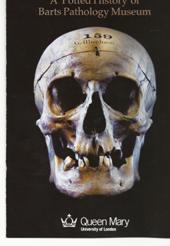
The Museum, part of Queen Mary college of London University, houses over 5,000 medical specimens, many of them terrifyingly on open view and one of its prized exhibits (pictured above) is the skull of John Bellingham, a noted East Anglian who, in 1812, carried out the only successful assassination of a British Prime Minister (to date).
The reason for my visit to the museum, however, was to not to mourn the murder of Spencer Perceval – whose name, these days, only crops up in pub quizzes – but to listen to a brace of lectures scheduled to mark the 66th (?) anniversary of the discovery of the mutilated body of Elizabeth Short in Los Angeles in what became known as the (still unsolved) ‘Black Dahlia’ case.
It was a pleasure to meet the first lecturer, Dr Steve Powell of Liverpool University, whose work on American crime writing – and especially that of James Ellroy – I have followed with interest and highly recommend his ‘blog’ or website, whatever the right word is, The Venetian Vase (http://venetianvase.co.uk/)
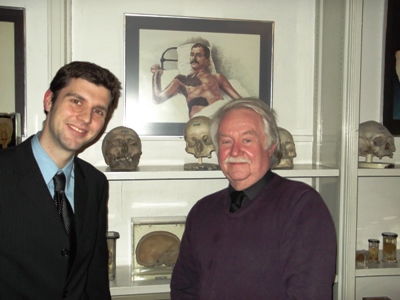
I had no idea until I heard Dr Powell’s lecture of the influence Elizabeth Short’s murder had – spurred on by the Press’ soubriquet of ‘Black Dahlia’ – on American crime fiction and true crime writing, but then it was a gruesome murder with all the trappings of a Jack the Ripper killing and, similarly, no perpetrator ever brought to justice.
Having had my sinews suitably stiffened by a couple of specially commissioned ‘Black Dahlia Cocktails’ (they were indeed black and did not stint on the vodka), I thought I was prepared for the second lecture of the evening, from pathologist Professor Peter Vanezis, OBE, who spoke with terrifying enthusiasm on dismemberment in several famous British murder cases including that of the ‘Crossbow Cannibal’ murders in Bradford, on which he did an awful – and I do mean awful – lot of work, fortunately in vain as the murderer, clearly as insane as they come, not only admitted his crimes but seemed quite proud of them.
I should, however, point out that Bart’s Pathology Museum also puts on less bloodthirsty events. Notably, on 13th February, there is a public seminar entitled Mending Broken Hearts which will discuss the benefits of wine and chocolate for the heart. Now what’s not to like about that? For further information, see http://eshop.qmul.ac.uk/browse/extra_info.asp?compid=1&modid=2&prodid=324&deptid=34&catid=1 though I am warned this is for the over-18s only, which may be something to do with the no-doubt realistic ‘heart-shaped’ cupcakes which will be available at the event.
Backlash
It might have been due to my exposure to the horrors of real crime at Bart’s Museum (and especially Professor Vanezis’ illustrated lecture on dismemberment) that, on my return to Ripster Hall, my heart sank when I discovered the next two books on my to-be-read list both concerned serial killers.
For once, I will be completely honest with my faithful readers and admit that I did not manage to finish either of them, though for entirely different reasons.
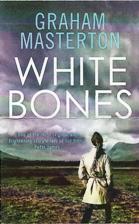
My first abandonment (for which I do blame Professor Vanezis rather than the book) was White Bones from Head of Zeus by Graham Masterton.
|
|
For 35 years and 70 books or more Graham Masterton has carved out a reputation as a master practitioner in the horror genre, but White Bones is marketed as his first crime novel. Certainly it has an intriguing protagonist in Detective Superintendent Katie Maguire of the Irish Gardai, significantly the first female detective of such rank in Ireland. Katie is an interesting and well-drawn, complex character and we first meet her investigating the discovery of a mass deposit of skeletons on anIrish farm, though one cannot help feeling that if only she had called in a local archaeologist, things might have gone quicker. So far, so good, but then we see Katie publicly insulted by a journalist at a press conference – which may well happen in Ireland, but is unthinkable behaviour by a member of Her Majesty’s Press – and we cut into a linked plot-line involving a present day serial killer preying on unsuspecting American tourists and using a flensing knife to great and gruesome effect. (If anyone does not know the meaning of ‘flensing’ then they should ask a Norwegian how their whale meat used to be harvested.)
When the flensing begins on a still-alive victim, I recalled some of the stomach-churning slides shown at Bart’s Museum and I am afraid, at that point, I must have lost my presence of mind. I am sure White Bones will be a great success among the legion of Mr Masterton’s horror genre fans but I am afraid it is not for sensitive souls such as me.
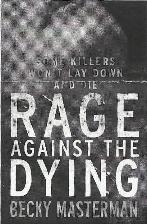
The second serial-killer thriller which I found I was unable to finish was Rage Against The Dying (Orion) by American Becky Masterman, of which I had heard many promising things.
For example, it had an unusual setting – the American south-west – and an unusual heroine in the shape of the 59-year-old former FBI agent Brigid Quinn, who, in her prime, unsuccessfully tracked a very nasty ‘Route 66’ serial killer and who, in retirement, is herself a potential victim for another ‘Squeals on Wheels’ serial killer. So far, so uncomfortable; but quite exciting and enthralling as Brigid Quinn is, initially, just the sort of interesting, unusual and resourceful heroine you want to cheer for.
But – and you knew there was a ‘but’ coming – despite the serial killer who breaks all the bones of his victims in the back of his van (hence ‘Squeals on Wheels’) and the Route 66 Killer who enjoys carnal relations with the mummified corpses of his victims and takes ears as trophies, all of which I could handle, it was when it came to the heroine’s relationship with her new, perfect husband that I found my stomach twitching. I am told that such heavy dosages of sugary sweetness and wifely subservience can be bad for the digestion.
To help recover my composure and to prove to myself that I was not a complete wimp, I decided to re-read the story of Freydis Eiriksdottir who holds the dubious distinction of being probably the first recorded female mass murderer in America. In a scenario later to be used mercilessly in Hollywood teenage ‘slasher’ movies, Freydis was part of an expedition of Greenlanders who set up a summer camp in cabins in the woods on the coast of what is now Maine. The devious Freydis played off one section of the camp against the other by faking her own rape and her loyal Vikings massacred those she had accused; Freydis personally taking an axe to five women witnesses.

All this, of course, happened around the year 1010 AD and was written down in the Graenlendinga Saga in 1190 AD. Now that’s what I call Nordic Noir.
Lives of the Saint(s)
My mention of the reissue of Leslie Charteris’ Saint books by Mulholland and the forthcoming television revival has helped fuel the flames of interest in this legendary figure, a flame which has dimmed occasionally in recent years, but never gone out.
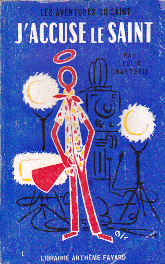 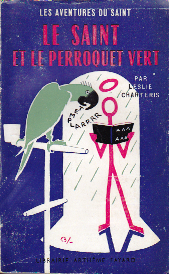 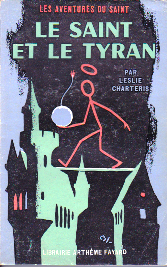
I am indebted to Terry Morris, a reader of this august column as well as The Saint, for sending me details of three Saint books from the 1950s which have never been published in English. J’Accuse Le Saint, Le Saint et le Parroquet Vert and Le Saint et le Tyran were stories adapted from Charteris’ radio scripts and a ‘Saint’ comic strip which ran in the New York Herald Tribune, which says quite a lot about the international appeal of the character.
Seamy South Africa
I have been a relatively recent convert to the blossoming school of South African crime-writing and particularly impressed with its most noirish practitioner, Roger Smith, whose new novel Capture is out from Serpent’s Tail this month.

This is not a book for the frail, faint-hearted or those planning a peaceful holiday in Cape Town; for it is an unremittingly bleak and very violent story populated by severely damaged characters most of whom get killed or commit a casual murder or two along the way. The rich/poor divide – more of a chasm than a divide – is clinically highlighted and violence, drugs and sexual exploitation are rife on both sides. No one seems immune; no one seems innocent as a domestic tragedy where a young girl drowns whilst her parents misbehave (in their different ways) escalates into a wave of slaughter rippling through brothels, slums and gated communities alike. Ironically, two of the survivors leaving Cape Town seeking an unlikely happy ending are both killers, so perhaps all morality is gone also.
This is an uncomfortable, always chilling read, at times downright unpleasant; but it is undeniably written with great power.
I Spy
I had been eagerly anticipating BBC4’s production of Alan Furst’s 2008 historical thriller The Spies of Warsaw ever since I heard that Dick Clements and Ian La Frenais had penned the script and that David Tennant was to play French army officer (and spy) Jean-Francois Mercier. I was not disappointed when it aired last month in two big-budget filmed episodes, the tie-in paperback edition being published by Phoenix.
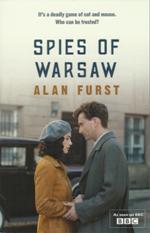
Set mainly in 1937-39 Poland and France, it looked splendid although at one point I thought I spotted the customers of a Czechoslovakian pub (in 1938) drinking their beer out of 1970’s Truman Brewery pint mugs. I did not, however, let that spoil my enjoyment of this excellent spy story, which saw excellent supporting performances from several Polish actors as well as British stalwarts such as Julian Glover, Anton Lesser, Ellie Haddington and Linda Bassett.
And speaking of spies, I had almost forgotten how much I used to enjoy the tough, deadpan adventures of Matt Helm, the fictional spy/assassin created by Donald Hamilton, who for far too long suffered from the tag ‘the American James Bond’.
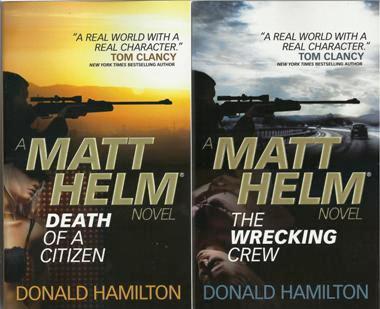
Thankfully, those inventive people at Titan Books, have embarked on a mass re-issue of the Matt Helm series, of at least eight of them (I think there were 27 in all) over the next year, commencing with the first two: Death of A Citizen and The Wrecking Crew, when, after 15 years, the ruthless wartime American agent Helm is drawn back into the violent world of espionage to do what he does best, which is kill bad guys. The books are tough and spare and a world away from the film versions made from four of the titles in the 1960s, starring Dean Martin as Helm, playing it tongue-in-cheek and very much for laughs. There was also a later television series of Helm adventures, though I do not think it was ever shown in the UK, and even talk, about five years ago, of a new movie version.
In a strange way, Donald Hamilton might just find himself in vogue again, given the craze for Scandinavian crime fiction, as he was born Donald Bengtsson Hamilton in Uppsala, Sweden in 1916, emigrating to the USA to live mostly in Santa Fe until shortly before his death in 2006 when he returned to his ‘native’ Sweden. He began his career writing thrillers and westerns (including The Big Country) in 1947 until the Matt Helm series started in 1960 and ran until 1993, although there are rumours of a final Matt Helm book still unpublished at the time of Hamilton’s death.
Revisiting the crime scene
I am not only contractually obliged (nay, contractually threatened) but actually quite proud to announce that the next author to feature in the fledgling imprint Ostara Crime, which I have the honour to edit, is my old friend Baroness Cohen of Pimlico, writing under the name of Janet Neel.
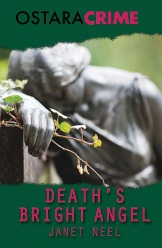
Three titles from her award-winning John McLeish and Francesca Wilson series from the years 1988-1993 – Death’s Bright Angel, Death of a Partner and Death Among the Dons – are being republished simultaneously as print on demand paperbacks and ebooks. Ostara have already published three titles by Christine Green and three by Denise Danks and three by Lesley Grant-Adamson will follow in the Spring, making Ostara Crime an all-British, all-female imprint… so far.
Detectives in Space and Time
Crime-writing is a broad church and good crime-writing, like travel, broadens the mind and I have always enjoyed the fact that I would be introduced to detectives from every conceivable country and time period. After more than 20 years of reviewing, covering over 1,000 novels, I thought I had seen it all; but the real beauty of crime fiction is that one never has.

I have just discovered my first Maasai warrior detective, named Mollel, in Richard Crompton’s debut novel The Honey Guide, which is published here by Weidenfeld later this month though I believe will be retitled Hour of the Red God when it appears in America in April. [As in most cases these days, publishing dates are nominal. The book has already been reviewed, over a month ago, on Amazon.] Set in Nairobi in Kenya on the eve of the 2007 presidential elections, The Honey Guide does not shrink from tackling issues ranging from female circumcision to political corruption and ethnic rivalries.
Moving continents – and nipping back in time about 1,900 years – the place, Ancient Rome, and the period (89 AD) may seem familiar but the fictional detective is new; well, sort of.

Fans of Lindsey Davis’ ‘Falco’ series will need little encouragement from me to try her new novel The Ides of April which is published by Hodder on April 11th (even though the Ides in April is actually the 13th, but who cares?) and introduces a new fictional detective in the feisty form of Flavia Albia, the adopted daughter of ace imperial sleuth Marcus Didius Falco, one of the most-beloved heroes of detective fiction.
Given that Flavia Albia (‘Albia’ because she was born in Britain) is a bit of an animal rights activist, the ‘entertainment’ put on in the Circus Maximus and the daily sacrificial offerings in pagan Rome’s many temples are likely to be as a red rag to a Mithraic bull to her. There may be trouble ahead as she embarks on her career as an investigator – I certainly hope so.
And in translation…
I have no idea if the translations of the titles of the two latest crime novels to appear from the innovative Bitter Lemon Press are accurate; as I am afraid both my Catalan and my Turkish are non-existent. There are however, two of my favourite titles of the year.
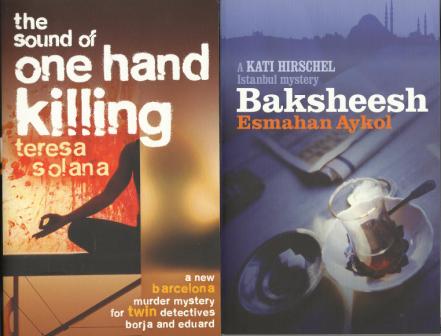
The Sound of One Hand Killing is Barcelona-based Teresa Solano’s third satirical crime novel to feature her twin brother detectives Borja and Eduard and once again people will be calling her ‘the Queen of Catalan Noir’. If they are not, they should.
Esmahan Aykol’s new novel featuring Kati Hirschel, the proud owner of Istanbul’s only crime fiction bookstore, is the wonderfully titled Baksheesh, which I believe is a word of Persian origin. Anyone who has ever spent an evening in a Public Bar with a couple of old ‘Eastern Hands’ regretting the passing of the British Empire, or a lunch time in a Fleet Street wine bar with a certain generation of journalists, will know instantly the meaning of the word. My younger readers (and there might be one somewhere) may well have come across the word in one of Eric Ambler’s thrillers from the 1938-1940 period. If, whether you are young or old, you have never heard of Eric Ambler, then please stop reading this column immediately.
Damn you, Oscar!
The Oscar nominations for 2013 are out and I am appalled. Where, oh where, is the Nomination for Best Supporting Actor for Lee Child’s towering performance in the movie Jack Reacher?
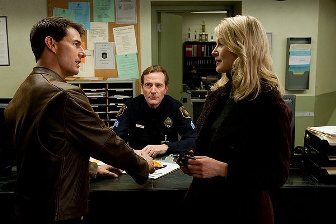
I think we should be told.
Side-effect?
The social and psychological effects of reading too much crime fiction have long been discussed by sociologists, doctors and profilers, even, it seems, back in 1941 when this little known (and quite surprising) American study was first published, for which I am grateful to the website The Passing Tramp.
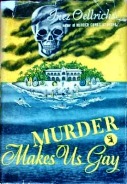
Toodles!
The Ripster
|